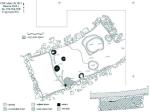Summary (English)
EXPLORATIONS NEAR THE VILLAGE OF IVANCHA (Deyan Rabovyanov – rabovyanov@gmail.com, Stiliyan Ivanov, Stoyan Mihailov, Julieta Giuleva) The settlement was situated on a high terrace and covered over 20 ha. An area of 6670 sq. m was excavated. Relatively small number of Early Bronze Age sherds was discovered. Pits Nos. 1 and 5 contained a large quantity of burned fragmentary wattle-and-daub and sherds of the Late Bronze Age. Grave No. 7 of the Late Bronze Age was discovered. The body was laid in a fetal position with its head to the east. The radiocarbon dating of the burial was c. 1490 BC. A ceramic jug was found in the grave. Dug-out Structure No. 55 dated to the 6th – 5th century BC. The earlier settlement discovered on the site dated to the end of the 8th – beginning of the 10th centuries AD. Nine dugouts were discovered, eight with stone stoves and one with a hearth. Seven ovens, a hearth and five pits were explored close to the dugouts. Grave No. 14 contained a pagan inhumation burial. The body was oriented to the east. The burial was probably Pecheneg. The later settlement on the site dated to the Ottoman period. Judging from the coins, it existed during the 16th – first half of the 17th centuries. According to the Ottoman tax registers, the name of the village was Iovan. The following structures were discovered: 22 sunken-floored houses, three houses, 31 sunken-floored storage buildings, seven large buildings, probably stables, 31 domestic ovens, a blacksmith’s hearth, a pottery kiln, and 64 pits, including storage and midden pits. Twelve Christian burials were discovered. Grave No. 1 contained a wooden coffin and an Ottoman silver akçe was found on the chest of the body. The man buried in Grave No. 10 had boots with iron hobnails and a brimmed hat. Graves Nos. 11 and 13 belonged to a child and a woman thrown face down into a pit inside a stable. Remains from a leather pouch with a folding knife and a silver 3 Grossus of Sigismund III Vasa minted in 1600 were discovered close to the pelvis of the woman. Probably, this was a criminal case.
- Deyan Rabovyanov - Veliko Tarnovo Branch of the Archaeological Institute and Museum
- Stiliyan Ivanov - Veliko Tarnovo Branch of the Archaeological Institute and Museum
- Stoyan Mihailov - Regional Museum of History - Veliko Tarnovo
- Julieta Giuleva - Department of Archaeology, Veliko Tarnovo University St. Cyril and St. Methodius
Director
- Deyan Rabovyanov - Veliko Tarnovo Branch of the Archaeological Institute and Museum
- Julieta Giuleva - Department of Archaeology, Veliko Tarnovo University St. Cyril and St. Methodius
- Stiliyan Ivanov - Veliko Tarnovo Branch of the Archaeological Institute and Museum
- Stoyan Mihailov - Regional Museum of History - Veliko Tarnovo
Team
Research Body
- Veliko Tarnovo Branch of the Archaeological Institute and Museum






![Download [PDF]](/excavation/skins/fasti/images/results/download_sml.png)


